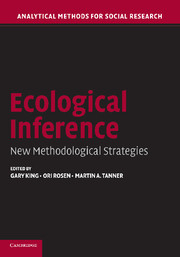Book contents
- Frontmatter
- Contents
- Contributors
- Preface
- INTRODUCTION
- PART ONE
- PART TWO
- PART THREE
- 9 Ecological Inference in the Presence of Temporal Dependence
- 10 A Spatial View of the Ecological Inference Problem
- 11 Places and Relationships in Ecological Inference
- 12 Ecological Inference Incorporating Spatial Dependence
- PART FOUR
- Index
11 - Places and Relationships in Ecological Inference
Uncovering Contextual Effects through a Geographically Weighted Autoregressive Model
Published online by Cambridge University Press: 18 May 2010
- Frontmatter
- Contents
- Contributors
- Preface
- INTRODUCTION
- PART ONE
- PART TWO
- PART THREE
- 9 Ecological Inference in the Presence of Temporal Dependence
- 10 A Spatial View of the Ecological Inference Problem
- 11 Places and Relationships in Ecological Inference
- 12 Ecological Inference Incorporating Spatial Dependence
- PART FOUR
- Index
Summary
ABSTRACT
One of the most salient but less studied features of ecological inference is the presence of spatial structure inducing aggregation bias in the observed data. This lack of attention is due to the fact that in most ecological inference models aggregation bias and spatial aggregation bias have been confounded. In this article we take advantage of a geographically weighted auto-regressive approach (GW-AR) to ecological inference that incorporates information about the underlying sources of spatial aggregation bias in ecological inference. We then show how this spatial information can be incorporated into most ecological inference methods as a covariate. Finally, we use Monte Carlo simulations to study the performance of the adjusted EI and Goodman models in the presence of spatial effects.
INTRODUCTION
One of the most salient but less studied features of ecological inference is the presence of spatial structure inducing aggregation bias in the observed data. This lack of attention is due to the fact that in most ecological inference models aggregation bias and spatial aggregation bias have been confounded into one and the same thing. However, provided that we know the location of the observable ecological units, there exists considerable more information about spatial aggregation bias than about most other nonspatial sources of bias.
- Type
- Chapter
- Information
- Ecological InferenceNew Methodological Strategies, pp. 245 - 265Publisher: Cambridge University PressPrint publication year: 2004
- 2
- Cited by

